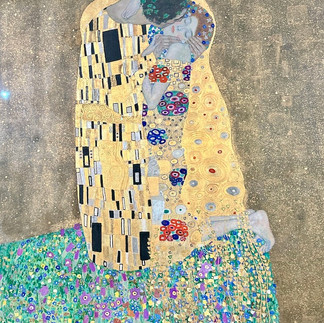Belvedere Palace Museum - Vienna
- Rosette Media

- Mar 5, 2024
- 4 min read
Nestled in the 3rd District of Vienna, The Belvedere in Vienna is one of the leading museums worldwide. Its famous art collection includes works ranging from the Middle Ages to the present day. Austrian art in an international context is presented in three locations. Highlights include the world's largest collection of Gustav Klimt paintings as well as prominent works from the periods of Viennese Biedermeier, Austrian Baroque, Vienna around 1900, and French Impressionism. The institution's central tasks focus on exhibiting, researching, collecting, communicating, and preserving. Ongoing advancements and digitalisation in all areas ensures the Belvedere’s significance as an outstanding museum of the future.
We spent an afternoon together with Art mediator Barbara Lenz who took me through the paces of Upper Belvedere, where we explored the distinctive pieces over the eras and periods; I had the plain pleasure of admiring all the masterpieces in a stunning baroque setting, a cultural journey through Austria's rich heritage via an exclusive guided tour; Lenz' knowledge is amazing having spent over 20 years with the Belvedere.. she took me to share the amazement of Vienna in the midst of the twentieth century: when it was a grand imperial city, a true magnet for artists and intellectuals, melting pot of many nations. Gustav Klimt, Egon Schiele, and Oskar Kokoschka shaped fin-de-siècle Vienna with their artistic innovations. This tour brought me in sync together with outstanding works of art from this tumultuous time.

The unique, overall complex, with its two palaces, the Upper and Lower Belvedere, and their extensive gardens, is one of the most stunning Baroque architectural ensembles in the world. In the 18th century, the Austrian general Prince Eugene of Savoy commissioned the renowned Baroque architect Johann Lukas von Hildebrandt to build a summer residence.
After the death of Prince Eugene, Empress Maria Theresa acquired the entire complex and transformed the Upper Belvedere into an exhibition venue for the imperial collections – making it one of the first public museums in the world. The Marble Hall was the venue for important historical events and now offers an unparalleled view of Vienna. The Lower Belvedere, formerly the residence of Prince Eugene, is home to illustrious exhibitions. The modern pavilion of the Belvedere 21, by architect Karl Schwanzer, sets the stage for contemporary art.
Sala terrena
The Sala Terrena (ground floor hall) is dominated by four mighty atlases supporting the richly stuccoed vaulted ceiling of the room. Initially, the Sala Terrena was designed as a uniform spacious hall, but after structural damage in the winter of 1732/33, the installation of the four supports became necessary. The hall opens onto to the garden side of the Upper Belvedere and leads to the Grand Staircase; thus, the Sala Terrena serves both as the garden hall and vestibule.
The Belvedere is a museum of influence, a museum of relevance.
A museum of relevance has a presence in people’s minds and hearts. It is a point of reference in a disorienting present. A historical constant, it links the past with the future. It is independent. It sees itself as a learning and teaching organization. A museum of relevance takes a stand on contemporary issues and social policy. It raises its voice for art and its democratizing potential. It takes responsibility for ecological concerns about the planet. Its contribution to the development of society promotes social justice. Its attitude sets an example, its voice is heard.
Exhibition - Permanent Collection
This presentation of the collection looks beyond a purely stylistic history of art to focus on the interactions between art and society. Influenced by the political and social environment, migration, international networks, and also by economic conditions, artistic production reflects the complexity of its time.
Each section of the display highlights selected self-portraits. They act as a leitmotif, offering an insight into the changing image and self-conception of artists through the centuries, ranging from anonymity and dependence to autonomy. The self-portraits accompany the visitor on this chronological tour through the world-famous collection of the Belvedere—through eight hundred years of art history from the Middle Ages to the 1970s.
Middle Ages – Renaissance
The earliest works in the Belvedere’s collection are paintings and sculptures dating from the late 12th century up to around 1600. These displays chart the transition from Romanesque to Gothic art and finally to the emerging Renaissance. A key development was the shift from anonymous art in the service of religion to self-confidently signed works that gave a new visibility to artists.
Baroque
Pomp and drama characterize Baroque art, yet in this period we also encounter realistic depictions of landscapes and everyday objects. Important works com- missioned by the aristocracy and the Church paint a diverse picture of the time. Entirely unique are Franz Xaver Messerschmidt’s “Character Heads,” a mysterious series that has inspired multiple interpretations and continues to fascinate viewers to this day. I found this astonishingly delightful and expressive, fascinating and wonderful! Calm..
Toward the end of the 19th century, Vienna was growing into a metropolis. Numerous artists were engaged in creating decorative schemes for the grand buildings of the Ringstrasse. This flourishing of the arts paved the way to the foundation of the Vienna Secession. Gustav Klimt was already Vienna’s most acclaimed painter; the Belvedere acquired The Kiss during the artist’s lifetime. This period also saw growing recognition and renown for women artists.
Belvedere Palace Museum
Address: Prinz-Eugen-Straße 27, 1030 Wien, Austria
Phone: +43 1 795570
More information here..




































Comments